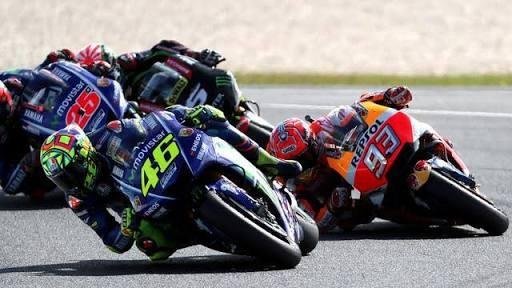history motogp

1949 to 1970S Edit
The world championship for motor racing was first organized by Fédération Internationale de Motocyclisme (FIM), in 1949. At that time there have traditionally been organized several races in every event for various motor classes, based on engine capacity, and classes for sidecars, . The existing classes were 50 cc, 125 cc, 250 cc, 350 cc, and 500 cc for single seater motors, and 350 cc and 500 cc for sidecars motors. Entering the 1950s and throughout the 1960s, motor-engine 4 did not dominate the entire class. In the late 1960s, motor 2-engined engines began to dominate small classes.
1970 to 2000S Edit
In the 1970s motor 2 engine did not really get rid of 4-stroke engines. In this period several motors such as the Kawasaki H1-R, MV Agusta 500 Three, chose to use two-stroke three-cylinder engine. With its three-cylinder motor, MV Agusta successfully bought the world champion racers in the range 1966 - 1973. In previous years, MV Agusta also succeeded with four-cylinder motor since 1956 - 1965 through racers John Surtees, Gary Hocking and Mike Hailwood. Selection of three-cylinder engine is usually backed up to get a light weight so that it is able to execute the bend faster and obtain better qualification results
In 1979, Honda attempted to return a four-stroke engine in the top class by lowering the NR500 motor, but the project failed, and even in 1983 Honda was able to win with its 500 cc 2 stroke motors. In 1983, the 350 cc class was finally abolished. The 50 cc class was later replaced by the 80 cc class in 1984, but the class often dominated by the Spanish and Italian racers was finally abolished in 1990. The sidecars class was also eliminated from the world championship in the 1990s, leaving 125 cc, 250 cc, and class 500 cc.
In the era of the 1997s when most of the Grand Prix 500 motor using four-cylinder engine, KR3 Modenas recorded as the only team as well as manufacturers who still use three-cylinder engine. Unfortunately up to the arrival of the era of 4-stroke three-cylinder engine KR3 can not do much, because lost power with the engine emapt cylinder, although on the other side gain benefits in terms of weight.
GP 500, the class that became the pinnacle of Grand Prix motor racing, has changed dramatically in 2002. From the mid-1970s to 2001 the top class of GP racing is limited to 4 cylinders and 500 cc engine capacity, either 4-stroke engine type or 2 not. As a result, which can survive is a 2-stroke engine, which in fact produces more power and acceleration.